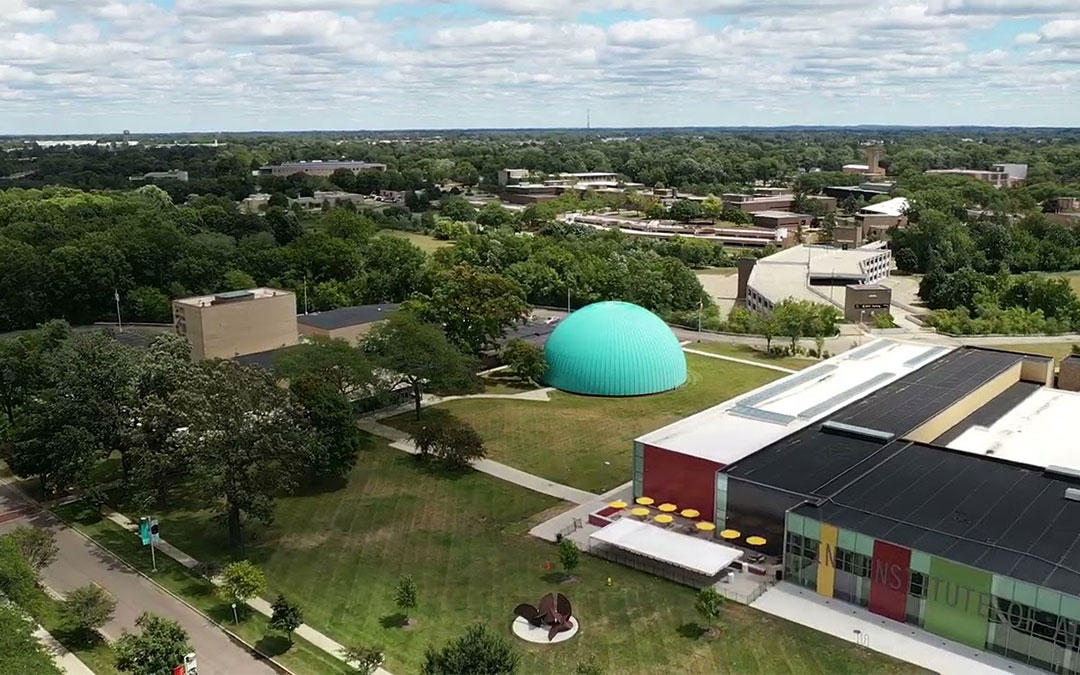Editor’s note: The December 2023 edition of this publication related the story of Robert T. Longway, the major sponsor and benefactor of the Flint Cultural Center. There were many other people involved who contributed money to be sponsors. Here are the short stories of the Black sponsors, often forgotten, who were also financial benefactors of the Flint Cultural Center. We feel it is appropriate to honor them in this Black History Month.
The Flint College and Cultural Center is a jewel that most cities would love to have in their community. Funded by donations, it was a gift to the citizens of Flint made possible with private funds. Corporations were the big donors to the Center, but individuals and their families could also become sponsors with a gift of $25,000 or about $260,000 today. This put sponsorship beyond the means of most people. Those donating were members of families who had done well investing in General Motors or banking.
In January 1960, a group of twenty-five Black citizens and their families banded together, each pledging $1,000 so that together they made the $25,000 minimum amount. Amazingly this was the only group of individuals that became sponsors.
Dr. Jessie Leonidas Leach, pioneer Black physician, civil right leader, and politician, met with thirty-five Black professionals and business owners and asked if they would be willing to join him in pledging to the future of Flint. Twenty-five agreed and Dr. Leach approached the College and Cultural Development committee with the offer. Robert T. Longway, President of the committee, was very enthusiastic and accepted.
Longway called it an ‘encouraging sponsorship’ and ‘a display of civic responsibility’ in an article in the January 10, 1960, Flint Journal.
So, in brief, who were these twenty-five who pledged the equivalent of just over $10,000 in 2023 dollars? Dr. Leach not only organized the group, but he was also a contributor. A graduate of Central Tennessee College and Meharry Medical College, Dr. Leach served in the American Expeditionary Force in World War I, he was the Assistant Flint City Physician in 1924 and the first Black person on the Genesee County Board of Supervisors. Leach also served on the State and National Boards of the NAACP as well as being a member of Kappa Alpha Psi.
Dr. J. Merrill and Edith Prunty Spencer, owners of the House of Spencer Mortuary, not only fulfilled their original pledge they went on to give an additional $25,000 in 1984. Dr. and Mrs. Spencer were active in the community but also were responsible for the lawsuits that abolished restrictive covenants for cemetery plot ownership and allowed Black people to be buried in what had previously been all White cemeteries.
Abraham L. Meyers, caterer, restaurant owner, bail bondsman and formerly the head waiter at the Pick-Durant, Flint’s premier hotel. Meyers was born in New York and came to Flint as a young man in 1921 after having served as a corporal in World War I.
The name C. Frederick Robinson will be familiar. Attorney Robinson was a graduate of Howard University and a part of Flint’s most famous civil rights causes including a ten-day sleep-in on the lawn of Flint City Hall in favor of the Flint Fair Housing Act and Dr. and Mrs. Spencer’s cases against Flint Memorial Park.
Electrical contractor and Chevrolet metal finisher, John Speed was the founder of Speed’s Electric, Speed’s Dairy and Grill, and Better Builders. He was also the father of Flint community leader and politician Raynetta Speed.
Flint’s first Black dentist was Dr. James Donald (J.D.) Wilson, he was a 1930 graduate of the University of Michigan School of Dentistry and a member of Alpha Phi Alpha.
Dr. Wilson’s son, James D. Wilson, Jr. was a graduate of Howard University and a career employee of the U.S. Agency for International Development.
Dr. Clarence Kimbrough was another graduate of Meharry Medical College who settled in Flint. Dr. Kimbrough not only contributed to the group sponsorship, he and his wife, Catherine, went on to donate as a couple. Dr. Kimbrough was the first Black person to sit on the board of Citizen’s Bank and the second to sit on the Flint Board of Education. He became the first Black person to be president of the Board of Education. Dr. Kimbrough was deeply involved in the Cultural Center serving on the boards of Flint Institute of Arts and the Flint Cultural Center.
Frederick Waller was a well-known Flint pharmacist and later the lead pharmacist at Hurley Hospital. Waller came to Flint as a young man and graduated from Flint Central High School in 1940. He was a member of Alpha Phi Alpha and served as the Master of Boy Scout Troop 45.
Thomas and Josephine Sims (Simms) were owners of Sims Grocery and a confectionary store in the St. John Street neighborhood. The Sims were active in community affairs and were honored with the Community Services Award by the Flint Negro Business and Professional Women’s Club in 1969.
Ailene Butler, Flint’s first Black City Councilwoman and long-time funeral home operator. She came to Flint as a young girl and was a graduate of Flint Northern High School as well as Wayne State University. Bulter was a member of the NAACP and one of the organizers of the Flint Fair Housing demonstrations in 1967. She also had the distinction of being the first Black Girl Scout leader.
Golden Gloves boxer, dry cleaner and businessperson Oscar Calloway was another donor. He and his wife, Leola, operated a dry cleaner in the St. John neighborhood and then opened Calloway’s Cleaners in the North Flint Plaza.
Memory (Mem) Allen Wright a long-time funeral director and educator contributed to the pledge. Wright had been a high school principal in Maryland before coming to Flint and later opened Wright’s Funeral Home in the former Watkins and James Funeral Home.
Better known as the first Black Michigan Auditor General, first Black University of Michigan Regent, first Black Michigan State Supreme Court Justice and the first Black General Counsel for General Motors, Otis Milton Smith was among those pledging to the Cultural Center. Smith had an incredible career as an attorney which took him to national prominence.
Machine operator for Chevrolet and Urban League Secretary, Arthur J. Edmonds also donated to the fund. He came to Flint after serving in the U.S. Army in World War II and worked for Chevrolet for 33 years.
Wrex Alger Weaver was another graduate of Meharry College. He was a member of the class of 1944 in dentistry. A member of Kappa Alpha Psi and veteran of World War II, Dr. Weaver opened his dental practice in Flint after the war. His son, Wrex Weaver III, later joined his father in the practice and is still active.
Politician, member of the Michigan House of Representatives from 1952-1964, auto worker, and realtor, Roger B. Townsend, was another well-known community figure to join the group and donate. Townsend was the second Black person from Flint elected to the Michigan State House.
John Bernard Tyiska had been a teacher in Crockett, Texas before he came to Flint. Unable to find work as a teacher he became a cement finisher. In the 1960s Flint Community Schools hired Tyiska and he taught until he retired from Holmes in 1980. He was deeply involved in his church serving as three-term president of Quinn Chapel. He was a charter member of the local chapter of Kappa Alpha Psi.
John F. Young was another graduate of Howard University and an attorney. After serving in the Adjutant General’s Office in World War II he came to Flint and was an assistant prosecuting attorney for Genesee County.
He was the first Black representative from Flint to serve in the Michigan State House. Young served for two terms, 1948-1952. He was also a member of Kappa Alpha Psi. John Young died when he was only fifty-eight on July 21, 1960.
Roosevelt and Victoria Ridgeway were engaged in multiple business ventures. He was the president of Ridgeway Development Corporation, and she started the first female owned taxicab service in Flint. They went on to develop apartment complexes in Flint on Lippincott Boulevard and Lapeer Road.
Dr. James E. Hawkins was a graduate of Flint Central in 1922 and the University of Michigan Medical School in 1931. He began practicing medicine in Flint in 1934 and for six years, 1953-1959, was the solicitor of medical gifts to the Red Feather Fund. Dr. Hawkins was the brother-in-law of Frederick Waller.
Joseph Lott, restaurant owner and the head of maintenance at Summerfield Chevrolet, contributed to the pledge. Lott was a life member of the NAACP, attended Quinn Chapel and was a member of the Eureka Masonic Lodge.
Dr. Arthur Herbert Johnson was another medical practitioner among the twenty-five. Dr. Johnson was originally from Mississippi and came to Flint after living in St. Louis, Missouri. Dr. Johnson and his family later left the Flint area and relocated to Washington, D.C.
The Reverend Charles Granderson Prichett, a Baptist minister and post office employee, was a contributor to the fund. Reverend Prichett served at Mt. Calvary Baptist Church in Flint.
Benny (Benjamin James) McNeeley came to Flint from Missouri. He worked at the Buick as a machine operator and was a member of Mount Olive Baptist Church.
Dr. T. Wendell Williams, a pharmacist and medical doctor, is our final contributor. Dr. Williams was the first Black person elected to the Flint Board of Education and was serving as treasurer at the time of his death in 1966. His wife Marion Coates Williams was the first Black classroom teacher in Flint schools, working at Parkland and Fairview Elementaries. The Board of Education named Williams Elementary School in his honor. The couple’s youngest daughter, Dr. Karen Williams Weaver, was the first woman elected Mayor of Flint.
The original sponsor memorials by the reflecting pool west of the Longway Planetarium recorded all College and Cultural Center Sponsors.
These twenty-five named as ‘Flint Negro Citizens,’ a short, dated phrase that really does not tell the entire story.
Special thanks to Wanda Harden and Edith Prunty Spencer for telling me about this little-known piece of Flint History, providing the genesis for this piece.






